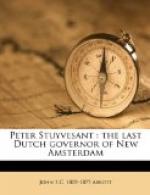The Dutch Director, thus disappointed in obtaining assistance from the English, was roused to the energies of desperation. The spirit of the people also rose to meet the emergency. It was determined to commence the most vigorous offensive measures against the savages.
We have not space to enter into the details of this dreadful war. We will record one of its sanguinary scenes, as illustrative of many others. The Connecticut Indians, in the vicinity of Greenwich, had joined the allied tribes, and were becoming increasingly active in their hostility. Ensign Van Dyck was dispatched with one hundred and fifty men in three vessels. The expedition landed at Greenwich. The Indian warriors, over five hundred in number, were assembled in a strongly palisaded village in the vicinity of Stamford.
It was midnight in February, 1644, when the expedition approached the Indian village. All the day long the men had toiled through the snow. It was a wintry night, clear and cold, with a full moon whose rays, reflected by the dazzling surface of hill and valley, were so brilliant that “many winter days were not brighter.”
The Dutch, discharging a volley of bullets upon the doomed village, charged, sword in hand. The savages, emboldened by their superior numbers, made a desperate resistance. But in a conflict like this, arrows are comparatively powerless when opposed to muskets. The Indians, unable to reach their foes with their arrows, made several very bold sallies, recklessly endeavoring to break the Dutch lines. They were invariably driven back with great loss. Not one of them could show himself outside the palisades without being shot down.
In less than an hour the dark forms of one hundred and eighty Indian warriors lay spread out upon the blood-crimsoned snow. And now the Dutch succeeded in applying the torch. The whole village, composed of the most combustible materials, was instantly in flames. The Indians lost all self-possession. They ran to and fro in a state of frenzy. As they endeavored to escape they were, with unerring aim, shot down, or driven back into their blazing huts. Thus over five hundred perished. Of all who crowded the little village at nightfall but eight escaped. Only eight of the Dutch were wounded; but not one fatally.
The conflagration of an hour laid the bark village in ashes. Nothing remained. The victors built large fires and bivouacked upon the snow. The next day they returned to Stamford, and two days afterward reached fort Amsterdam.
War is generally ruin to both parties. In this case neither of the combatants gained anything. Both parties alike reaped but a harvest of blood and woe. Scouting parties of the savages prowled beneath the very walls of fort Amsterdam, ready at a moment’s warning, to dart into the wilderness, where even the bravest of the Dutch could not venture to pursue. For the protection of the few cattle which remained, all the men turned out and built a stout fence, “from the great bowery or farm across to Emanuel plantation,” near the site of the present Wall street.




